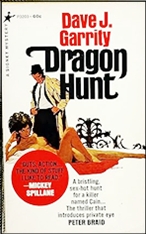Wed 19 Nov 2025
A 1001 Midnights PI Review: DAVE J. GARRITY – Dragon Hunt.
Posted by Steve under 1001 Midnights , ReviewsNo Comments
by Max Allan Collins
DAVE J. GARRITY – Dragon Hunt. PI Peter Braid. Signet, paperback original, 1967.
Dave Garrity seems unfairly destined to be a footnote in the career of Mickey Spillane. With the phenomenal popularity of Spillane in the 1950s, a group of satellite writers sprang into orbit around him: “buddies” of the Mick’s who solicited cover blurbs and contacts in the writing business to launch their own careers as hard-boiled mystery writers.

Earle Baskinsky flamed out after two vivid, idiosyncratic novella-length books (The Big Steal and Death Is a Cold, Keen Edge, both 1956), as did Charlie Wells, after two readable, Spillane-imitative books (Let the Night Cry, 1954, and The Last Kill, 1955).
Only Garrity — who sometimes published under the single-name by line Garrity — carved out a career of his own. His only published private-eye novel to dale (several novels completed shortly before his death in 1984 may see posthumous publication) is Dragon Hunt, in which he unashamedly tapped into the success of Mike Hammer.
Although Dragon Hunt is one of Garrity’s lesser works, it has been singled out for discussion because it features Mike Hammer as a character, making it of interest to students of Spillane, whose importance is, after all, undeniable.
With Spillane’s blessing (right down to cover blurb and a photo of the Mick and Garrity on the back cover), the novel that “introduces private eye Peter Braid” ties directly into the world of Mike Hammer in many ways. The title is a reference to “the dragon,” the villain of Spillane’s novel The Girl Hunters> (1961), to which Dragon Hunt is vaguely a hack-door sequel.
Throughout the novel Braid calls Hammer on the phone for advice and help, perhaps mirroring the Garrity/Spillane relationship. (Spillane claims not to have provided Hammer’s dialogue, but one assumes he at least checked it over.)
The basic plot — a dying millionaire named Adam hires the PI to protect his granddaughter from a prodigal, psychotic son named Cain — is lifted from the syndicated “Mike Hammer” comic strip in 1954, right down to the names of the characters. Spillane wrote the Sunday pages of the strip and collaborated with artist Ed Robbins on the daily scripts.
In his entry in Contemporary Authors circa ’63, Garrity mentions as a work in progress a book that is obviously Dragon Hunt — then titled Find the Man Called Cain — to be done in collaboration with Ed Robbins. This would explain the Hammer strip as source material for the novel, but not the lack of Robbins’ name on the by-line. In any case, Dragon Hunt is a minor, slightly tongue-in-cheek, but likable affair, and a must for Spillane enthusiasts.
Those who wish to see Garrity at his best, however, should seek out his Cordolini series for New American Library. In these four novels (an unpublished fifth one is known to exist), Garrity reveals himself to be an ambitious writer, experimenting with characterization via quirky effective dialogue; using third-person shifting viewpoints boldly; and generally avoiding the schlocky mock”Executioner” approach of similar series of the same period.
His finest hour is The Plastic Man (1976), which features a narrative trick so deft, so surprising, that the most seasoned mystery reader will have to give Garrity his due.
———
Reprinted with permission from 1001 Midnights, edited by Bill Pronzini & Marcia Muller and published by The Battered Silicon Dispatch Box, 2007. Copyright © 1986, 2007 by the Pronzini-Muller Family Trust.